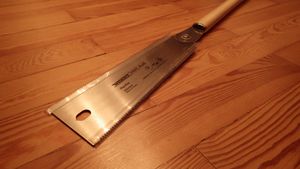Japanese Saws: Difference between revisions
From CoMakingSpace Wiki
→Ryoba: added photo |
m *short* note on other styles |
||
| Line 17: | Line 17: | ||
}} | }} | ||
A "Ryoba" has two cutting sides, one with hardened crosscutting teeth and one with simple larger teeth for quick cuts along the grain. | A "Ryoba" has two cutting sides, one with hardened crosscutting teeth and one with simple larger teeth for quick cuts along the grain. | ||
== Other Styles == | |||
* Dozuki: Japanese backsaw | |||
* Kataba: similar to Dozuki, but no back | |||
[[Category:Saws]] | [[Category:Saws]] | ||
[[Category:Woodworking]] | [[Category:Woodworking]] | ||
Revision as of 17:56, 26 December 2017
Japanese woodworking saws cut on the pull stroke, as opposed to "Western" ones that cut when you push. This allows the blade to be made extremely thin, but also makes it easier to accidentally bend it by pushing too much!
Ryoba
| ToolInfoBox Ryoba | |
|---|---|

| |
| Synonyms: | DE: "Japansäge" |
| Type: | hand saw |
| Material: | wood |
| Location: | wood workshop |
| Access Requirements: | upon reading |
| Tutors: | Lukas |
A "Ryoba" has two cutting sides, one with hardened crosscutting teeth and one with simple larger teeth for quick cuts along the grain.
Other Styles
- Dozuki: Japanese backsaw
- Kataba: similar to Dozuki, but no back